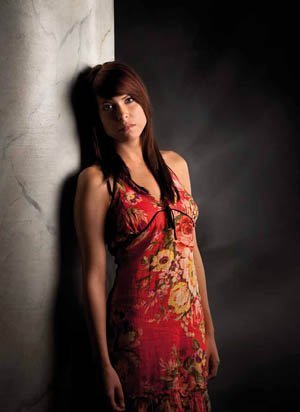articles/Lighting/eggcratelightmodifiers-page1
Lighting for digital - Dave Montizambert looks at egg-crate light modifiers - part 1 of 1 2
by Dave Montizambert Published 21/10/2009

Dave Montizambert looks at egg-crate light modifiers
Many times I have been asked about my dramatic, signature lighting style which is both soft and high contrast. One of the key issues is controlling the light spill from the large diffused light sources that are required to create soft light. To look at this in more depth I'm going to use a shot I did from this past August, created for a Canadian company called Lighttools Inc. My assignment was to create a series of images using their soft egg-crate light-bank modifiers (see Image 04) which they manufacture, to create some dramatic lighting on some fine looking humans. This series of photo shoots I did was video taped by Edmonton cinematographer Jim Tustian to be used on the Lighttools' website (www.lighttools.com) as an education piece on the effect of the egg crates and how to use them. Photographers, cinematographers, and videographers use these light modifiers (called grids by some), on soft-boxes and scrims because they give an incredible amount of control over large light sources - they transform these omni-directional sources into directional sources while maintaining most of their soft light characteristics.
Soft egg crates grew out of the mind of Edmonton, Alberta photographer, Stephen Pilby. Stephen thought that there must be a better solution for light-bank light control than the rigid aluminum honeycomb grids that came on the market in the late 1980s. He began manufacturing a soft version made of a black nylon material that is easily attached to a lightbank using Velcro™. This soft version is much more portable than the honeycomb grid since it folds up to a very small size, and is much less expensive since it costs less to manufacture

My specialty is dramatic lighting. I know that dramatic lighting can get complicated when the subject requires soft-edged lighting as in the case of the image which I created of model Natasha Hamilton for the Lighttools video of stills shoot, see Image 01. To create a soft light quality on a subject you need to work with relatively large light sources positioned close to the subject, see the 3x4 foot Chimera soft-box in the lighting diagram of Image 02. For lighting people this usually means using soft-boxes or scrims - scrims are also called light panels. The challenge with these sources is that they diffuse the light making it omni-directional - once the light rays emitted from the light origin (strobe tube, halogen bulb, etc.) pass through the white diffusion material of the soft-box or scrim, they spatter out in all directions (180˚) from any given point. Unfortunately this unwanted light-spill hits areas of the set that need to stay dark for the dramatic feel. Adding an egg crate blocks the light particles that spill out to the sides, horizontally as well as vertically, making it possible for a large source of illumination to throw directional light while maintaining most of its soft light characteristics. This blocking of the light causes an added side benefit that I love; the blocking of light by the egg-crate cells is gradual meaning that the pattern of light projected onto a subject fades out at the edges gradually, kind of like a soft vignette. Being able to spot-light your subject with soft light is a very artistic way of using lighting to draw the viewer's eye to key areas of the image.
As cool as egg-crate control is, you may be wondering, can't you do this same soft spot lighting effect later with Photoshop? The answer is you can. But when using a soft egg-crate on a light-bank, only the pattern of light on the subject from that one light source is 'vignetted', not the whole image. In other words, creating this effect with lighting allows us to control the light pattern in a three-dimensional space, whereas creating the effect with Photoshop we have to make do with a two-dimensional space - all of the components of the subject and scene are no longer separated by space but are flattened together. That is not to say that it is impossible in Photoshop. However, it tends to be very time consuming since selections or masks are required to isolate the effect of the vignetted light pattern to a select object or objects. When lighting for digital we often run into situations like this where we have a choice to control lighting effects with the lights or in Photoshop, to make the best decision always let common sense be your guide, weigh out quality and speed against time and budget.
You are currently on page 1
- Lighting for digital - Dave Montizambert looks at egg-crate light modifiers page 1
- Lighting for digital - Dave Montizambert looks at egg-crate light modifiers page 2
1st Published 21/10/2009
last update 09/12/2022 14:53:43
More Lighting Articles
There are 2 days to get ready for The Society of Photographers Convention and Trade Show at The Novotel London West, Hammersmith ...
which starts on Wednesday 14th January 2026





